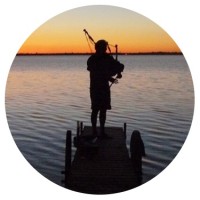Who was Sir John A MacDonald?
Sir John’s family was originally highland. Highlanders were clan based, oral society who spoke Gaelic, not English (or Scots); they were predominantly Catholic. I’ve surmised because of his name that sometime in the 1700s, his family, either forced or for their own reasons left the western highlands (where that sir name originated). Sir John’s father Hugh was born in Dornoch Scotland (on the east coast but still in the highlands). Sir John was born in Glasgow (1815), a lowland city. I’ve seen no record that Sir John spoke Gaelic. They were Presbyterian when they came to Canada.
The family left Scotland in 1820 and eventually settled in Hay Bay (Bay of Quinte area of Canada). They were middle class. When they finally had enough money, John was sent away to school.
So basically, Sir John’s family had moved out of their longtime home, lost their culture, lost their language, changed the flavour of their religion, sent children away for schooling.
There were different major cultures in Scotland; not so much today. We have a habit of lumping them all into the majority “Hoot mon, Scots Wa Hae” ilk. That is a very different culture, but is the one we now envision whey thinking Scottish. With the encouragements of King George IV, Scotland has appropriated the kilt as its national garb (but the small one, not the great kilt originally from the Highlands); appropriated the bagpipe (but most often playing music in the style developed by the British army’s schools of piping) and they speak the lowland Scots, a language that is kin to English.
The highland culture (language and dress) was purposefully discouraged (the Proscription Act). Today, Highland Gaelic is pretty well gone (estimated to be down to 60,000 speakers world wide). The people have been scattered – the clan lands that gave its name to where I live here in Canada was sold off to and the people encouraged to then were forcibly moved.
Sir John came from that background (a people, culture and language) that had to become something else to survive and improve. How is it then so difficult understand a program of boarding schools to inculcate the language and norms of the majority society?
My background.
I am a 5th generation slow propagating Canadian of highland Gael descent. I believe the family from whom I derive my last name left the greater Hebrides maybe two generations before they left the highlands. Our family lore (passed down by a great-aunt who carried our story into the mid 1900s.) is that we came from the Sleat peninsula of the Isle of Skye. There is written record that the family had moved to the north side of the Firth of Forth before leaving Scotland and settling in the Huntington QC area (1925 census). When it was possible, they then moved to Glengarry County ON. The name carrier was a miller (and is recorded as such in the 1852 Upper Canada census) his son a merchant, my grandfather a university grad who also became a merchant; my father was a general surgeon and I am a Civil Engineer. I believe the family came to Canada speaking English; however, my paternal Grandmother’s family (who came up from the Mohawk Valley to escape the retributions for being loyal during the American revolution) spoke Gaelic, but would not pass it on.
My dad was a piper and piped at school and in the military (I play his pipes). He, in the early 1950s, took me to a movie about a highland rogue/folk hero. My mom (from a family descended from middle march Scots) asked how it went. Dad said I think his heritage was showing.
There is an adage (now in English) that the Gaelic society believed you couldn’t be smart if you couldn’t remember but the dominant culture believes that you can’t be smart if you don’t write and read.
I was brought up in Quinte area of southern Ontario – a reading and writing a very English speaking part of the province. I now live in Glengarry County. Here people have kept some of the highland culture. Although we have become a “civilized” place there is still an underlying empathy for story telling.
The lost culture of a people who easily blend in, is easy to forget.
Hopefully, this adds some background to the origin of my thoughts
Now, my name rant.
MacDonald is an English spelling of a Gaelic patronymic. First M’, Mc, Mac (or any other variation) are the same thing; basically what a scribe (probably not from the culture) thought he (yes he) heard. It means son of (patronymic) and we’ve adopted it for a sir/family name.
A simple definition is: Donald is a masculine given name derived from the Gaelic name Dòmhnall (and I’ve seen different spellings of the “… nall” part). Note. There is no ending “d”. That too has been added by the English. The pronunciation is heavy on the “Do” (sort of doe) the “mhn” almost disappears and the vowel in “all” is not emphasized. Think of the Irish name Connell (another scribe’s spelling of the same Gaelic name). It’s COn ‘ll. I’ve listened to the language change as people try to improperly distinguish between the various incorrect English spellings of a good Gaelic name.
The Plaidneck
(and remember, normal is vastly over-rated)
